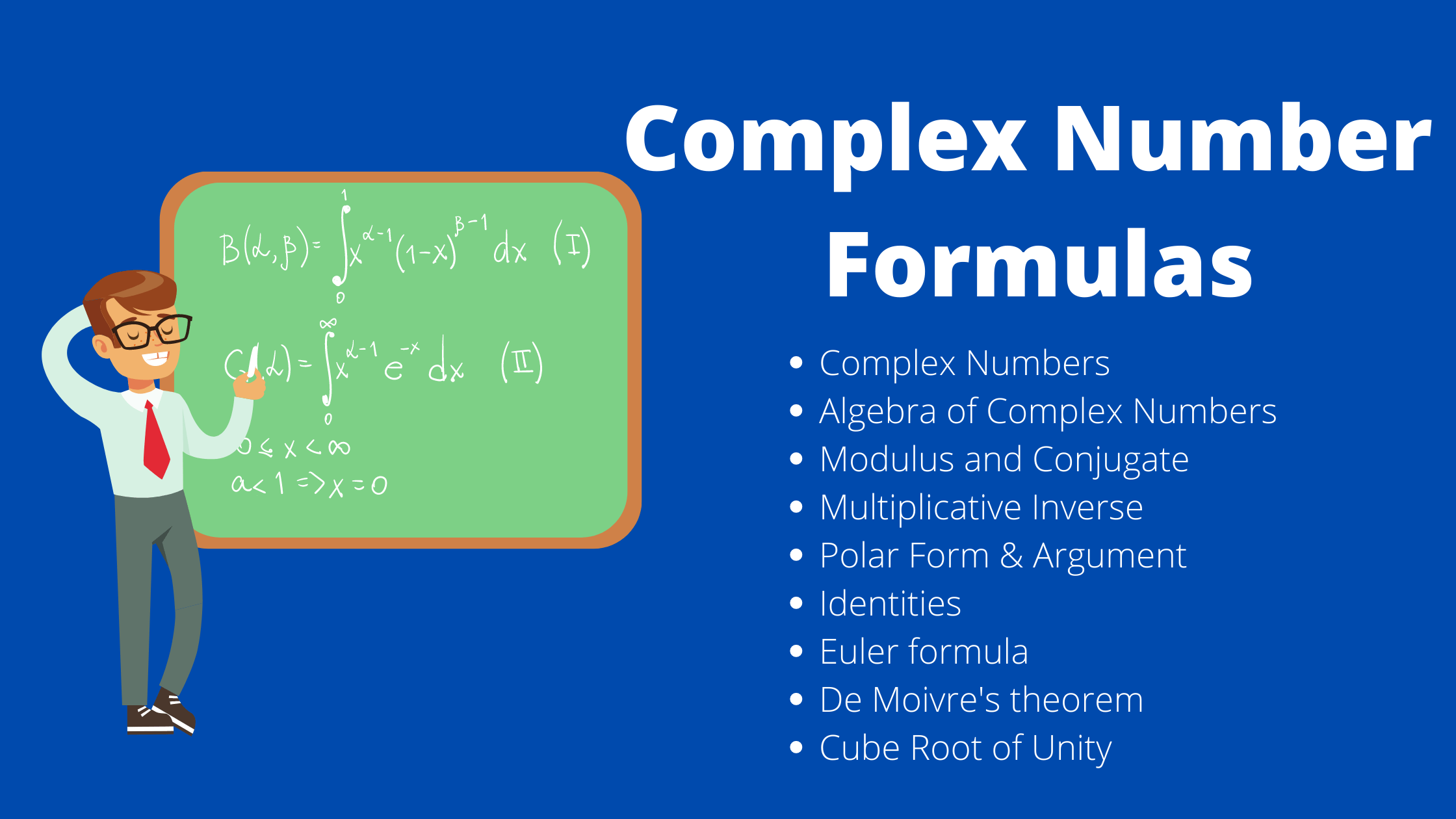
Complex Numbers is an important topic. Here are list of Complex Numbers Formulas
Complex Numbers
Complex numbers are defined as an ordered pair of real numbers like (x,y) where
$z=(x,y)=x+iy$ and $i = \sqrt {-1}$
and both x and y are real numbers and x is known as real part of complex number and y is known as imaginary part of the complex number.
Addition of complex numbers
Let z1=x1+iy1 and z2=x2+iy2 then
z1+z2=(x1+x2)+i(y1+y2)
Subtraction
z1-z2=(x1-x2)+i(y1-y2)
Multiplication
(z1.z2)=(x1+iy1).(x2+iy2)
Multiplicative Inverse
for $z=a+ib$
z-1 is given by
=$(\frac{a}{a^{2}+b^{2}})+i(\frac{-b}{a^{2}+b^{2}})$
Complex conjugate
$z=x+iy$ Then complex conjugate is given by
$\bar{z}=x-iy$
Properties of Complex Conjugate
- $\bar(\bar{z})=z$
- $z+\bar{z}=2x$
- $z-\bar{z}=2iy$
- $z\bar{z}=(x^{2}+y^{2})$
- $\overline {z_1 -z_2}=\bar {z_1} -\bar {z_2}$
- $\overline {z_1 +z_2}=\bar {z_1} +\bar {z_2}$
- $\overline {z_1 z_2}=\bar {z_1} \bar {z_2}$
- $\overline {\frac{z_1}{z_2}}=\frac {\bar {z_1}}{\bar {z_2}}$
Modulus of Complex Number
Modulus of the absolute value of z is denoted by |z| and is defined by
|z|=$\sqrt{(x^2+y^2)}$
Properties of modulus
- $z \bar{z}= |z|^2$
- $|z_1z_2| =|z_1 z_2|$
- $|\frac {z_1}{z_2}|=\frac {|z_1|}{|z_2|}$
- $|z_1+z_2|\leq|z_1|+|z_2|$
- $|z_1-z_2|\geq |z_1>|-|z_2>|$
Polar Form
- Let r be any non negative number and $\theta$ any real number. If we take $x=rcos\theta$ and $y=rsin\theta$ then, $r=\sqrt{x^2+y^2}$which is the modulus of z and $\theta=tan^{-1}\frac{y}{x}$ which is the argument or amplitude of z and is denoted by arg.z
- we also have $x+iy=r(cos\theta+isin\theta)=r[cos(2n\pi+\theta)+isin(2n\pi+\theta)]$ , where n=0, ±1, ±2, ….
- Argument of a complex number is not unique since if $\theta$ is the value of argument then $2n\pi + \theta$ (n=0, ±1, ±2, ….) are also values of the argument. Thus, argument of complex number can have infinite number of values which differ from each other by any multiple of $2 \pi$
- The unique value of $\theta$ such that $\pi < \theta <= \pi $ is called the principal value of the amplitude or principal argument
- The principal argument of the complex number is find using the below steps
Step 1) for z=a+ib , find the acute angle value of $\theta=tan^{-1}|\frac{y}{x}|$
Step 2) Look for the values of a ,b
if (a,b) lies in First quadrant then Argument=$\theta$
if (a,b) lies in second quadrant then Argument =$\pi-\theta$
if (a,b) lies in third quadrant then Argument =$-\pi+\theta$
if (a,b) lies in Fourth quadrant then Argument =$-\theta$
- Arg(0) is not defined.
- argument of positive real number is zero.
- argument of negative real number is $\pm \pi$
Identities of Complex Number
For all complex numbers z1 and z2
- (z1 + z2)2 = z12 + z22 + 2z1z2
- (z1 – z2)2 = z12 + z22 – 2z1z2
- (z1 + z2)3 = z13 + z23 + 3z1z22+ 3z12z2
- (z1 – z2)3 = z13 – z23 + 3z1z22 -3z12z2
- z12 – z22 = (z1 + z2 )(z1 – z2)
Euler’s formula
- For any real number x, eix = cos x + i sin x
- Let z be a non zero complex number; we can write z in the polar form as,
z = r(cos ? + i sin ?) = r ei?, where r is the modulus and ? is argument of z. - $z \times e^{i \alpha} = re^{i \theta} \times e^{i \alpha} = re^{i(\alpha + \theta)}$
De Moivre’s theorem
De Moivre’s theorem states following cases
- Case I It states that for any integer n,
$(cos \theta + i sin \theta)^n= cos (n \theta) + i sin (n \theta)$ - Case II if n is of the form p/q where p, q are integers and q > 0
then
$(cos \theta + i sin \theta)^n =cos (2k \pi+ \theta) \frac {p}{q} + sin (2k \pi + \theta)\frac {p}{q}$
Where k=0,1,2,…q-1
Cube Root of Unity
- Cube Root of Unity are $1,\omega, \omega ^2$
- $\omega = \frac {-1+i \sqrt {3}}{2}$
- So cube roots are 1, $ \frac {-1+i \sqrt {3}}{2}$ and $ \frac {-1-i \sqrt {3}}{2}$
Properties of Cube roots of Unity
- $z^3 -1 =(z-1)(z-\omega)(z-\omega ^2)$
- $\omega$ and $\omega ^2$ are roots of the equation $z^2 +z + 1=0$
- Sum of the roots is $1+ \omega + \omega ^2 =0$
Hope you find this list of Complex Numbers Formulas Useful and helpful
Related Articles
Inverse Trigonometric Function Formulas
Differentiation formulas
Trigonometry Formulas for class 11
Trigonometric table